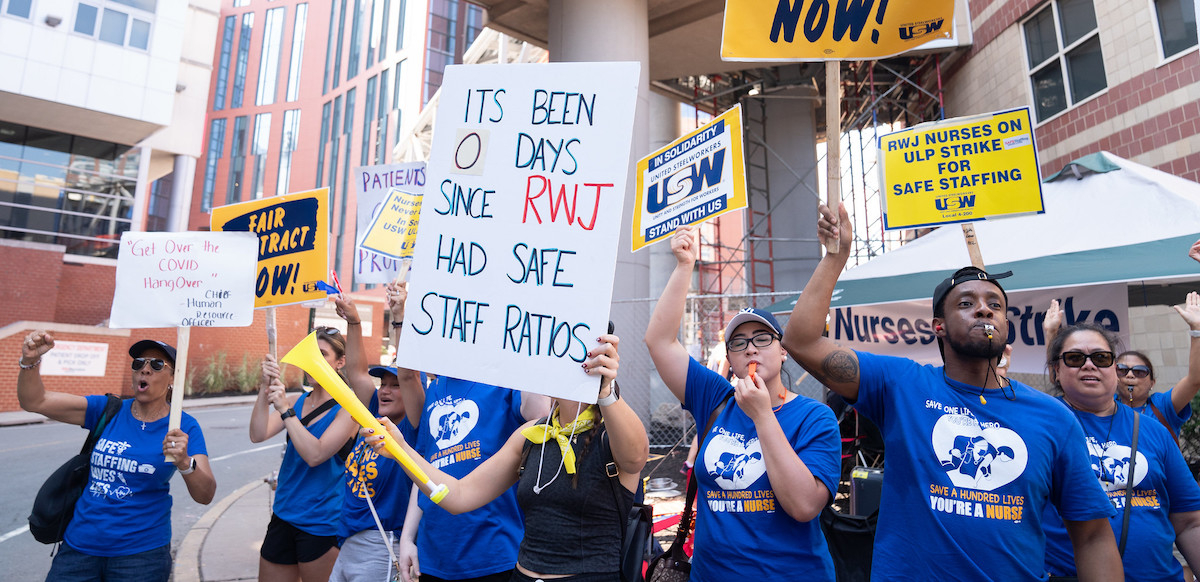New Jersey Nurses Two Months into Strike for Safe Staffing

Nurses at Robert Wood Johnson University Hospital in New Brunswick, New Jersey have been on strike since August 4. Photo: United Steelworkers.
There ought to be nine nurses on the day shift at 9 Tower, a trauma surgery unit inside the Robert Wood Johnson University Hospital in New Brunswick, New Jersey.
Instead, some days there are just three.
“Sometimes I’d look at a patient’s face and know that I won’t be able to maybe help feed them when they need to be fed,” said nurse Sophia Moccio, “or clean them when they need to be cleaned. It is distressing, and depressing for us.”
Staffing levels this bad are a major reason why she and 1,700 of her co-workers at RWJUH have been on strike since August 4.
Nurses in her 34-bed unit often have to manage the care of six patients apiece—and sometimes seven or eight. “Most of the patients are dealing with some really traumatic brain injury or something similar, and they need constant care and a watchful eye,” Moccio said. “But it’s hard to do that when you’re having six patients at a time.”
Short-staffing and burnout—longstanding issues for nurses across the country—are worse than ever. Since the start of Covid-19, RWJUH nurses say, they’ve seen many colleagues leave the profession or retire, pushed past their limits.
And for newer nurses like Moccio, the heavy patient loads are a “trial by fire” that leaves people “burnt out and exhausted,” she said.
“Many nurses feel their values as medical professionals are being ignored, or compromised,” Moccio said. “If the concerns of nurses aren’t taken more seriously, the cycle will perpetuate itself, and more will continue to retire or just leave the field.”
‘AN ABUSIVE RELATIONSHIP’
RWJUH is a 965-bed academic medical center associated with the medical school at Rutgers, and a level-one trauma center.
The nurses there, members of Steelworkers Local 4-200, have now been on strike for two months. Meanwhile rather than bargain, the hospital administration has found ways to retaliate—like stripping nurses of their health insurance on September 1.
“It’s all the trademarks of an abusive relationship,” Moccio said. “There is gaslighting. There is deceiving. They leverage these words of kindness, sweetness, and thankfulness for what we do while continually reminding us not to ask administration for what we need, and telling us we’re greedy when we do.”
The nurses proposed a 10 percent pay increase; the hospital countered with 3 percent. On staffing, the administration has offered only “guidelines” that would allow it to disregard safe staff-to-patient ratios if nurses called out sick.
“That is designed to pit nurses against each other,” Moccio said, “to pin the blame on nurses who might feel sick or overworked, when it’s the hospital administration that’s not doing their job.”
SCABS PAID DOUBLE
The hospital remains open, because the administration has been hiring traveling nurses to cross the picket lines. According to HealthJob, the average weekly travel nurse contract in New Brunswick was $4,405 per week, twice the national average for travel nurses.
A court has ruled against picketing outside the hospital, claiming it’s too disruptive. Now an injunction bars the nurses from gathering in large groups outside the hospital; they cannot delay or obstruct scab nurses from entering.
Five weeks into the strike, the nurses marched on the home of one of the hospital’s CEOs. Six weeks in, faced with a federal mediator’s proposal to accept management’s offer or submit to binding arbitration, the nurses voted by a resounding 89 percent to reject the latest offer and continue their strike.
“My hope, and why I voted for this strike, was not just for the benefit of patients and nurses at our hospital, but to open a conversation about what does nursing need in this time period, especially in a so-called post-Covid world,” Moccio said.
“Our issues are not specific to New Brunswick or to New Jersey. What we’re asking for is what all nurses should be asking for throughout the country.”
The faculty and graduate worker unions at Rutgers are supporting the strike; so are other unions and community groups. The strikers have garnered the public support of Senator Bernie Sanders, who also supported the Rutgers faculty strike earlier this year.
Until recently New Jersey Governor Phil Murphy had said little about the strike beyond urging “both sides” to get along. But in recent weeks he has become more vocal, praising the nurses.
AS FEW NURSES AS POSSIBLE
Earlier this year, after a three-day strike, 7,000 nurses at two major hospitals in New York City won a groundbreaking contract improving staff-to-patient ratios.
Californian nurses won a safe-staffing law in 1999, though it wasn’t until 2019 that another law was added to penalize hospitals that don’t comply. Even so, according to a 2010 study nurses in California experienced less burnout and less dissatisfaction with their jobs than nurses elsewhere—and for patients, the mortality rate was lower.
New Jersey nurses rallied this year to support a bill, A4536, that would establish California-style safe-staffing ratios at hospitals and surgical facilities. No success so far.
“Hospitals operate under the brutal and confounding economics of American health care,” New York Times opinion columnist Lydia Polgreen wrote recently. “Our system treats nurses more as a cost center than a value creator, so that the goal in too many cases becomes as few nurses as possible caring for as many patients as possible.”
Sudip Bhattacharya is a doctoral candidate in Political Science at Rutgers University and a writer for such outlets as Protean Magazine, Truthout, and Black Agenda Report. He is a proud member of his adjunct union, and was on strike this year.





